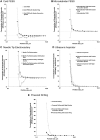Mitigation of Aerosols Generated During Rhinologic Surgery: A Pandemic-Era Cadaveric Simulation
- PMID: 32779974
- PMCID: PMC7424621
- DOI: 10.1177/0194599820951169
Mitigation of Aerosols Generated During Rhinologic Surgery: A Pandemic-Era Cadaveric Simulation
Abstract
Objective: After significant restrictions initially due to the COVID-19 pandemic, otolaryngologists have begun resuming normal clinical practice. However, the risk of SARS-CoV-2 transmission to health care workers through aerosolization and airborne transmission during rhinologic surgery remains incompletely characterized. The objective of this study was to quantify the number concentrations of aerosols generated during rhinologic surgery with and without interventions involving 3 passive suction devices.
Study design: Cadaver simulation.
Setting: Dedicated surgical laboratory.
Subjects and methods: In a simulation of rhinologic procedures with and without different passive suction interventions, the concentrations of generated aerosols in the particle size range of 0.30 to 10.0 µm were quantified with an optical particle sizer.
Results: Functional endoscopic sinus surgery with and without microdebrider, high-speed powered drilling, use of an ultrasonic aspirator, and electrocautery all produced statistically significant increases in concentrations of aerosols of various sizes (P < .05). Powered drilling, ultrasonic aspirator, and electrocautery generated the highest concentration of aerosols, predominantly submicroparticles <1 µm. All interventions with a suction device were effective in reducing aerosols, though the surgical smoke evacuation system was the most effective passive suction method in 2 of the 5 surgical conditions with statistical significance (P < .05).
Conclusion: Significant aerosol concentrations were produced in the range of 0.30 to 10.0 µm during all rhinologic procedures in this cadaver simulation. Rhinologic surgery with a passive suction device results in significant mitigation of generated aerosols.
Keywords: COVID-19; SARS-CoV-2; aerosol particles; aerosol-generating procedure; airborne; endonasal drilling; sinus surgery; skull base surgery.
Conflict of interest statement
Figures



Similar articles
-
One year into the COVID-19 pandemic: What do we know so far from studies assessing risk and mitigation of droplet aerosolisation during endonasal surgery? A systematic review.Clin Otolaryngol. 2021 Nov;46(6):1368-1378. doi: 10.1111/coa.13854. Epub 2021 Sep 14. Clin Otolaryngol. 2021. PMID: 34473910 Free PMC article.
-
Droplet and Aerosol Generation With Endonasal Surgery: Methods to Mitigate Risk During the COVID-19 Pandemic.Otolaryngol Head Neck Surg. 2021 Feb;164(2):285-293. doi: 10.1177/0194599820949802. Epub 2020 Aug 11. Otolaryngol Head Neck Surg. 2021. PMID: 32779964 Free PMC article.
-
Airborne Aerosol Generation During Endonasal Procedures in the Era of COVID-19: Risks and Recommendations.Otolaryngol Head Neck Surg. 2020 Sep;163(3):465-470. doi: 10.1177/0194599820931805. Epub 2020 May 26. Otolaryngol Head Neck Surg. 2020. PMID: 32452739 Free PMC article.
-
Aerosol Dispersion During Mastoidectomy and Custom Mitigation Strategies for Otologic Surgery in the COVID-19 Era.Otolaryngol Head Neck Surg. 2021 Jan;164(1):67-73. doi: 10.1177/0194599820941835. Epub 2020 Jul 14. Otolaryngol Head Neck Surg. 2021. PMID: 32660367 Free PMC article.
-
Diagnostic and therapeutic endonasal rhinologic procedures generating aerosol during COVID-19 pandemic: a systematized review.Braz J Otorhinolaryngol. 2021 Jul-Aug;87(4):469-477. doi: 10.1016/j.bjorl.2020.11.008. Epub 2020 Dec 13. Braz J Otorhinolaryngol. 2021. PMID: 33358322 Free PMC article.
Cited by
-
COVID-19 and rhinological surgery.Oper Tech Otolayngol Head Neck Surg. 2022 Jun;33(2):103-111. doi: 10.1016/j.otot.2022.04.005. Epub 2022 Apr 28. Oper Tech Otolayngol Head Neck Surg. 2022. PMID: 35502266 Free PMC article.
-
Are medical procedures that induce coughing or involve respiratory suctioning associated with increased generation of aerosols and risk of SARS-CoV-2 infection? A rapid systematic review.J Hosp Infect. 2021 Oct;116:37-46. doi: 10.1016/j.jhin.2021.06.011. Epub 2021 Jul 8. J Hosp Infect. 2021. PMID: 34245806 Free PMC article.
-
Reducing the risks of endoscopic sinonasal surgery in the Covid-19 era.Clin Otolaryngol. 2021 Jul;46(4):809-815. doi: 10.1111/coa.13743. Epub 2021 Mar 10. Clin Otolaryngol. 2021. PMID: 33590653 Free PMC article.
-
Pituitary surgery and COVID.Pituitary. 2024 Dec;27(6):909-915. doi: 10.1007/s11102-024-01423-x. Epub 2024 Jul 5. Pituitary. 2024. PMID: 38967764 Review.
-
One year into the COVID-19 pandemic: What do we know so far from studies assessing risk and mitigation of droplet aerosolisation during endonasal surgery? A systematic review.Clin Otolaryngol. 2021 Nov;46(6):1368-1378. doi: 10.1111/coa.13854. Epub 2021 Sep 14. Clin Otolaryngol. 2021. PMID: 34473910 Free PMC article.
References
-
- Centers for Disease Control and Prevention. Information for healthcare professionals about coronavirus (COVID-19). Accessed May 1, 2020 https://www.cdc.gov/coronavirus/2019-ncov/hcp/index.html
MeSH terms
Substances
LinkOut - more resources
Full Text Sources
Medical
Miscellaneous

